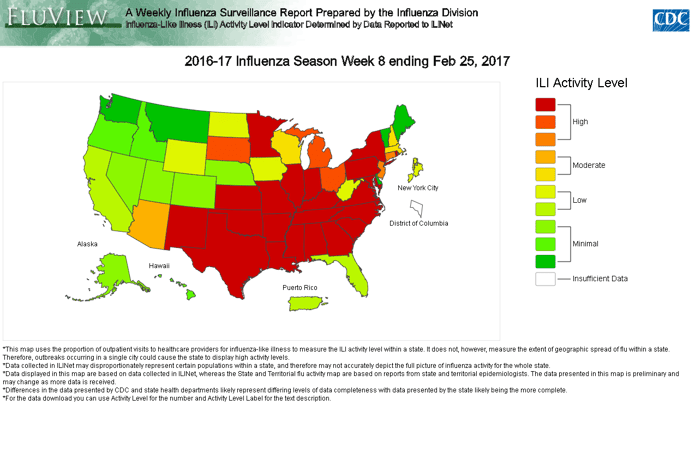
Each week during flu season, the Centers for Disease Control (CDC) posts FluView, a weekly influenza surveillance report prepared by the Influenza Division. The report provides a quick synopsis of important flu virus statistics presented in easy to read charts and interactive graphs. As February concluded the percentage of respiratory specimens testing positive for influenza in clinical laboratories remains elevated. During week eight of flu season, the most frequently identified influenza virus subtype reported by public health laboratories was influenza A (H3).
During week eight of flu season, the most frequently identified influenza virus subtype reported by public health laboratories was influenza A (H3).
Moreover, the proportion of deaths attributed to pneumonia and influenza (P&I) was above the system-specific epidemic threshold in the National Center for Health Statistics (NCHS) Mortality Surveillance System, and there were six Influenza-associated pediatric deaths reported.
In addition, a cumulative rate for the season of 39.4 laboratory-confirmed influenza-associated hospitalizations per 100,000 populations was reported. The proportion of outpatient visits for influenza-like illness (ILI) was 4.8%, which is above the national baseline of 2.2%. All 10 regions reported ILI at or above their region-specific baseline levels.
Providers should continue stressing the importance of properly and frequently washing hands with warm, soapy water, covering coughs and sneezes into the arm or a tissue, and staying home from school/work, when sick, to keep germs from spreading.
It is never too late to encourage patients to get a flu shot. The CDC recommends that everyone age 6 months and older get a flu vaccine each year. It is especially important for healthcare workers to get a flu vaccine to reduce the chance of transmitting illness to patients. Pregnant women should also get a flu vaccine to protect themselves and their newborns from serious flu illness.
With elevated flu activity throughout the United States, ensure that you are protecting your patients from vaccine preventable influenza virus subtypes by properly storing and handling your flu vaccine stock. For more information on how to properly store your flu vaccine, download our Ultimate Guide to Vaccine Storage.




